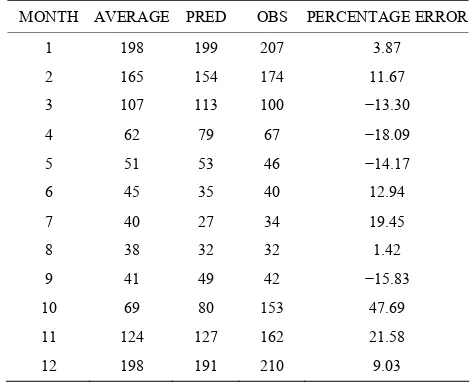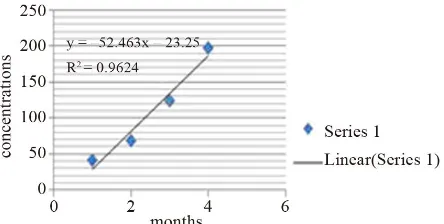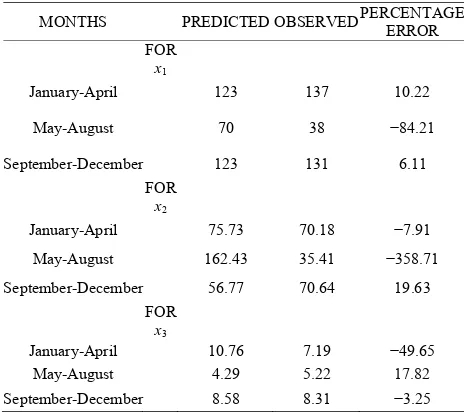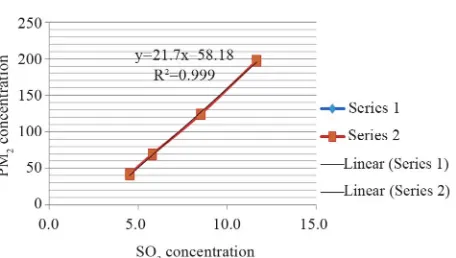Studies on Interrelations among SO
2
, NO
2
and PM
10
Concentrations and Their Predictions in
Ambient Air in Kolkata
Sayanti Kar1,2, Phalguni Mukherjee3
1Department of Environmental Studies, Women’s Christian College, Kolkata, India 2Department of Environmental Science, Asutosh College, Kolkata, India
3Department of Mathematics and Post Graduate Department of Environmental Science, Asutosh College, Kolkata, India Email: phalguni.mukherjee@gmail.com
Received July 10, 2012; revised August 19, 2012; accepted September 11, 2012
ABSTRACT
In this paper we have first of all studied the interrelations among the concentrations of SO2, NO2 and PM10 and then predicted their future level of concentrations in the ambient air of Kolkata. The data collected from West Bengal Pollution Control Board website have been used to construct second degree, third degree and four degree polynomial equations us-ing MATLAB software. Since a curve in a small interval can be approximated by a line segment in that small interval, we have observed that better result can be achieved if we replace the curves piece meal wise in small intervals by line seg-ments during January-April, May-August and September-December months. The multiple regression equations among the aforesaid three parameters have been established to predict the value of each parameter in terms of the remaining two. A further improvement in terms of reducing the number of dependent variables has been made using the results of correlation coefficients. Finally, we have predicted the value of each parameter in terms of only one dependent variable.
Keywords: Ambient Air; Multiple Correlation-Coefficients; Kolkata
1. Introduction
Metropolitan city like Kolkata has been suffering from various types of health hazards problems for long time due to air pollution. Risk assessments for the toxic pol- lutants are widely used in different countries as a regula- tory decision making processes to combat air pollution [1]. In the mega cities of India such as Mumbai, Delhi and Kolkata, PM10 has exceeded the regulatory limits [2,3]. It has been found from available data that the pre- sence of particulate matter (PM10) is highest in the at-mosphere of Kolkata. Among the pollutants listed in NAAQS [4] one of the most notorious pollutants is PM10. It is well known that PM10 is responsible for respiratory hazards in human health. Such particulates can also ob-struct lung function without reacting chemically, by de-positing in human lungs and interfering with normal functioning [5]. Moreover, it takes part in formation of sulphurous smog. One of the main sources of existence of PM10 in air is vehicular pollution. Various typical an-thropogenic activities like intense transportation, Indus-trial and commercial activities are prevailing in urban areas, particularly in the metropolitan cities [1,6-8]. It is also known that increased level of Sulphur-dioxide (SO2) and Nitrogen-dioxide (NO2)lead to the formation of
dif-ferent types of secondary pollutants in environment. Studies reveal that the occurrence is mainly due to expand- ing industries and growing number of vehicles within the state. The West Bengal Pollution Control Board (WBPCB) had initiated air quality monitoring of Kolkata through a limited number of stations in 1992 and subsequently ex-panded its monitoring network to systematic pattern from December 1998 [9]. At present the air quality of Kolkata is monitored through 16 fixed monitoring stations as mentioned in Methods and Materials.
2. Objective
segment in that small interval, we have considered the curves piece meal wise from January to April, May to August and September to December for all the para- meters. Then we have approximated the curves obtained in the above time periods by suitable line segments and found predictions are quite encouraging. Next we find multiple regression equations among PM10, SO2 and NO2 and predict the approximate value of one of the para- meters in terms of remaining two. Further, we have found out the correlation between each pair of parameters and used these results to reduce the number of dependent variables from two to one and predict any one of the parameters in terms of only one (dependent) parameter.
3. Methods and Materials
The average value of 24 hr daily ambient air quality in- formation has been collected during the period of 2003- 2010 for all three pollutants and subsequently their mon- thly averages have been obtained for each of these pollu- tants (Tables 1-3).
Table 1. The average month wise data for NO2 (Source:
Daily Ambient Air quality Information [10]; WBPCB) in terms of (µg/m³).
MONTH 2003 2004 2005 2006 2007 2008 2009 2010 January 82.24 74.50 93.90 96.00 95.10 91.90 98.90 106.00 February 71.85 73.30 91.90 74.20 76.40 81.10 87.10 92.50
[image:2.595.57.288.380.522.2]March 58.46 51.90 63.70 59.00 65.60 69.70 69.90 70.20 April 46.40 44.30 39.40 43.70 43.90 62.72 51.80 50.20 May 42.30 46.60 37.60 41.90 48.40 52.42 43.60 42.60 June 40.80 51.10 36.30 45.90 42.70 44.10 45.80 43.80 July 36.60 40.90 36.70 44.40 43.80 47.49 41.10 39.40 August 36.40 30.10 40.90 42.40 39.90 44.80 35.10 38.40 September 42.90 31.80 37.90 44.90 43.70 43.80 42.80 37.30 October 46.70 47.20 48.90 62.20 56.60 65.50 62.90 49.60 November 73.40 77.20 77.90 72.20 61.50 87.80 71.40 66.70 December 82.90 100.30 101.20 84.90 84.80 94.50 105.90 80.10
Table 2. The average month wise data for SO2 (Source: Dai-
ly Ambient Air quality Information [10]; WBPCB) in terms of (µg/m³).
MONTH 2003 2004 2005 2006 2007 2008 2009 2010 January 11.50 15.30 17.40 17.80 9.00 9.00 10.20 11.80 February 8.30 14.20 15.60 11.40 6.30 10.80 9.00 10.70 March 3.80 10.30 7.70 6.90 5.50 5.50 7.20 9.20
April 3.60 5.50 5.40 5.60 4.80 5.30 5.60 7.90 May 2.50 5.20 4.70 4.90 4.90 4.60 5.30 5.90 June 2.00 5.40 4.50 4.90 4.60 4.60 5.20 5.10 July 2.30 5.10 3.60 4.50 4.70 5.00 5.00 5.10 August 2.40 3.70 4.30 4.20 4.60 5.40 4.90 5.00 September 3.00 3.60 3.90 4.50 4.80 6.00 5.40 5.00 October 4.20 5.60 5.90 4.60 5.40 6.50 8.00 6.20 November 9.70 11.70 11.40 4.90 5.10 8.60 8.70 8.10 December 11.70 19.40 18.00 6.20 5.90 10.80 11.30 10.10
*2008 February data was not available in the website. So we have used the
average value of February Months of the rest seven years.
Study Area
Study area selected by WBPCB includes 16 stations in the city Kolkata, they are at Dunlop Bridge, Picnic Gard- en, Tollygunge, Hyde Road, Behala Chowrasta, Beliag- hata, Salt Lake, Tapsia, Baishnabghata, Ultadanga, Momin- pore, Moulali, Shyambazar, Gariahat, Minto Park, Rajar- hat New Township.
4. Results and Discussion
These primary data have been used to get non-linear curve for each case. We then use MATLAB to predict their concentrations by second degree, third degree and fourth degree equation (Tables 4-12).
The results thus obtained are quite good except in a few cases. So for obtaining better result in terms of accuracy, we have again divided the entire data into three segments i.e. from January-April, May-August and September-De- cember. In each case we get linear equations (Figures 1-9) and the predictions made are quite encouraging.
Table 3. The average month wise data for PM10 (Source:
Daily Ambient Air quality Information [10]; WBPCB) in terms of (µg/m³).
MONTH 2003 2004 2005 2006 2007 2008 2009 2010 January 204 196 211 202 223 174 195 178 February 186 186 203 154 118 140 163 167
[image:2.595.306.539.552.735.2]March 68 137 150 126 91 81 107 93 April 60 94 81 62 45 54 56 46 May 57 71 64 51 46 45 40 36 June 47 64 59 46 31 39 38 34 July 41 56 51 38 32 36 34 28 August 45 51 52 34 32 32 31 28 September 47 51 50 37 34 40 37 34 October 55 62 52 86 67 81 83 63 November 132 131 122 128 110 125 115 130 December 218 230 209 207 191 176 174 176
Table 4. Prediction of NO2 using second degree equation.
[image:2.595.57.287.568.717.2]Table 5. Prediction of SO2 using second degree equation.
[image:3.595.55.287.101.293.2]MONTH AVERAGE PRED OBS PERCENTAGE ERROR 1 12.75 12.99 9.26 −40.32 2 10.79 10.09 8.41 −19.93 3 7.01 7.73 5.51 −40.23 4 5.46 5.92 5.58 −6.01 5 4.75 4.65 5.47 14.95 6 4.54 3.94 4.88 19.32 7 4.41 3.77 5.09 25.93 8 4.31 4.15 5.44 23.68 9 4.53 5.08 5.80 12.39 10 5.80 6.56 8.61 23.82 11 8.53 8.59 7.48 −14.77 12 11.68 11.16 11.60 3.80
Table 6. Prediction of PM10 using second degree equation.
MONTH AVERAGE PRED OBS PERCENTAGE ERROR 1 198 210 207 −1.48 2 165 153 174 12.24 3 107 106 100 −6.25 4 62 71 67 −5.57 5 51 46 46 −0.29 6 45 32 40 18.83 7 40 30 34 12.57 8 38 38 32 −18.47 9 41 57 42 −35.76 10 69 87 153 43.10 11 124 128 162 20.98 12 198 180 210 14.33
Table 7. Prediction of NO2 using third degree equation.
[image:3.595.54.287.320.511.2]MONTH AVERAGE PRED OBS PERCENTAGE ERROR 1 92.32 92.99 94.60 1.70 2 81.04 77.77 81.42 4.49 3 63.56 64.41 60.68 −6.15 4 47.80 53.32 43.93 −21.36 5 44.43 44.86 40.98 −9.48 6 43.81 39.44 36.72 −7.41 7 41.30 37.44 31.73 −17.98 8 38.50 39.23 32.17 −21.95 9 40.64 45.21 37.77 −19.71 10 54.95 55.77 59.66 6.52 11 73.51 71.29 59.10 −20.62 12 91.83 92.15 127.40 27.67
Table 8. Prediction of SO2 using third degree equation.
[image:3.595.304.539.326.517.2]MONTH AVERAGE PRED OBS PERCENTAGE ERROR 1 12.75 12.80 9.26 −38.18 2 10.79 10.10 8.41 −20.14 3 7.01 7.85 5.51 −42.51 4 5.46 6.06 5.58 −8.68 5 4.75 4.76 5.47 12.91 6 4.54 3.98 4.88 18.54 7 4.41 3.72 5.09 26.88 8 4.31 4.03 5.44 25.95 9 4.53 4.92 5.80 15.20 10 5.80 6.42 8.61 25.48 11 8.53 8.55 7.48 −14.24 12 11.68 11.33 11.60 2.33
Table 9. Prediction of PM10 using third degree equation.
MONTH AVERAGE PRED OBS PERCENTAGE ERROR 1 198 199 207 3.87 2 165 154 174 11.67 3 107 113 100 −13.30 4 62 79 67 −18.09 5 51 53 46 −14.17 6 45 35 40 12.94 7 40 27 34 19.45 8 38 32 32 1.42 9 41 49 42 −15.83 10 69 80 153 47.69 11 124 127 162 21.58 12 198 191 210 9.03
Table 10. Prediction of NO2 using fourth degree equation.
[image:3.595.55.287.540.735.2] [image:3.595.303.539.544.736.2]Table 11. Prediction of SO2 using fourth degree equation.
[image:4.595.55.287.101.293.2]MONTH AVERAGE PRED OBS PERCENTAGE ERROR 1 12.75 13.18 9.26 −42.33 2 10.79 9.79 8.41 −16.40 3 7.01 7.47 5.51 −35.54 4 5.46 5.91 5.58 −6.00 5 4.75 4.91 5.47 10.28 6 4.54 4.31 4.88 11.72 7 4.41 4.06 5.09 20.27 8 4.31 4.18 5.44 23.12 9 4.53 4.79 5.80 17.49 10 5.80 6.06 8.61 29.67 11 8.53 8.26 7.48 −10.44 12 11.68 11.75 11.60 −1.31
Table 12. Prediction of PM10 using fourth degree equation.
MONTH AVERAGE PRED OBS PERCENTAGE ERROR 1 198 205 207 0.75 2 165 148 174 14.70 3 107 107 100 −6.84 4 62 77 67 −14.28 5 51 55 46 −19.21 6 45 40 40 −0.61 7 40 33 34 3.65 8 38 34 32 −5.38 9 41 46 42 −9.13 10 69 73 107 31.62 11 124 121 162 25.20 12 198 197 210 6.36
[image:4.595.317.540.209.308.2]Figure 1. Linear equation of NO2 during January-April.
[image:4.595.54.287.321.588.2]Figure 2. Linear equation of NO2 during May-August.
Figure 3. Linear equation of NO2 during September-De-
cember.
[image:4.595.54.287.322.588.2]Figure 4. Linear equation of SO2 during January-April.
Figure 5. Linear equation of SO2 during May-August.
Figure 6. Linear equation of SO2 during September-Decem-
ber.
[image:4.595.314.533.341.440.2] [image:4.595.311.541.612.714.2] [image:4.595.65.281.620.712.2]Figure 8. Linear equation of PM10 during May-August.
Figure 9. Linear equation of PM10 during September-De-
cember.
The prediction of NO2 during January-April is given by the equation
15.10 108.94
y x (1)
The prediction of NO2 during May-August is given by the equation
2.02 47.08
y x (2)
The prediction of NO2 during September-December is given by the equation
17.21 22.2
y x (3)
The prediction of SO2 during January-April is given by the equation
2.56 15.41
y x (4)
The prediction of SO2 during May-August is given by the equation
0.14 4.86
y x (5)
The prediction of SO2 during September-December is given by the equation
2.41 1.58
y x (6)
The prediction of PM10 during January-April is given by the equation
46.48 249.06
y x (7)
The prediction of PM10 during May-August is given by the equation
4.46 54.56
y x (8)
The prediction of PM10 during September-December is given by the equation
52.46 23.25
y x (9)
Results obtain from line segmentsare tabulated as ( Ta-bles 13-15).
Explanation of data given in Table 13: NO2: Average values of NO2 during 2003-2010; PRED: Predicted value of NO2 obtained from Figures 1-3; OBS: Month wise observed values of 2011.
Explanation of data given in Table 14: SO2: Average values of SO2 during 2003-2010; PRED: Predicted value of SO2 obtained from Figures4-6; OBS: Month wise ob- served values of 2011.
Explanation of data given in Table 15: PM10: Average values of PM10 during 2003-2010; PRED: Predicted va- lue of PM10 obtained from Figures 7-9; OBS: Month wise observed values of 2011.
Table 13. Prediction of NO2.
MONTH NO2 PRED 2011 OBS PERCENTAGE ERROR
1 92.32 93.80 94.67 0.92 2 81.04 78.70 81.42 3.34 3 63.56 63.60 60.68 −4.81 4 47.80 48.50 43.93 −10.40 5 44.43 45.05 40.98 −9.93 6 43.81 43.02 36.73 −17.13 7 41.30 40.99 31.74 −29.14 8 38.50 38.96 32.18 −21.07 9 40.64 39.41 37.80 −4.26 10 54.95 56.62 58.25 2.80 11 73.51 73.83 59.11 −24.90 12 91.83 91.04 127.40 28.54
Table 14. Prediction of SO2.
MONTH SO2 PRED 2011 OBS PERCENTAGE ERROR
[image:5.595.306.539.324.517.2]Table 15. Prediction of PM10.
MONTH PM10 PRED 2011 OBS PERCENTAGE ERROR
1 198 203 207 2.16 2 165 156 174 10.32 3 107 110 100 −9.56 4 62 63 67 5.85 5 51 50 46 −8.91 6 45 46 40 −14.10 7 40 41 34 −21.12 8 38 37 32 −14.75 9 41 29 42 30.43 10 69 82 107 23.66 11 124 134 162 17.20 12 198 187 210 11.14
We have divided the entire data into three segments, for each segment we have established a multiple regres- sion equation involving all the three parameters. The seg- ment-wise equations are as follows:
January-April: x1 75.18 2.44 x2 3.79x3
3 (10)
May-August: x1 100.67 0.25 x234.35x (11)
September-December:
1 51.47 0.49 2 25.23 3
x x x (12)
The results obtain from the above three equations are shown in Table 16.
Next we consider the average values of NO2, SO2 and PM10 from January-April, during 2003-2010 to find lin-ear relations between every pair of parameters. The re-sults for all the segments are shown in the following fig-ures and tables.
The correlation co-efficient of each of the three parameters during January-April, May-August, September-December are shown in Tables 17-19 and Figures 10-18 respec- tively.
3 2
0.169 3.064 . . 0.169 3.064
y x i e x x (13)
1 3
17.867 28.017 . . 17.867 28.017
y x i e x x (14)
2 1
0.3243 28.097 . . 0.3243 28.097
y x i e x x (15)
3 1
0.063 1.834 . . 0.063 1.834
y x i e x x (16)
1 3
31.34 97.72 . . 31.34 97.72
y x i e x x (17)
2 1
0.401 24.60 . . 0.401 24.60
y x i e x x (18)
2 3
0.141 1.592 . . 0.141 1.592
y x i e x x (19)
1 3
21.76 58.18 . . 21.76 58.18
y x i e x x (20)
2 1
0.319 30.79 . . 0.319 30.79
y x i e x x (21)
In the following table we have shown linear relations between every pair of parameters for all the three seg- ments.
From Table 16 and Table 20 we put together the re- sults in Table 21 where we have predicted each para- meter.
[image:6.595.306.538.239.445.2]1) In terms of remaining two parameters; 2) In terms of one of the remaining parameters.
Table 16. Prediction of x1, x2 and x3 with the help of
multi-ple regression equations involving all the parameters during the segments (January-April, May-August, and September- December).
MONTHS PREDICTED OBSERVED PERCENTAGE ERROR FOR
x1
January-April 123 137 10.22 May-August 70 38 −84.21 September-December 123 131 6.11
FOR
x2
January-April 75.73 70.18 −7.91 May-August 162.43 35.41 −358.71 September-December 56.77 70.64 19.63
FOR
x3
January-April 10.76 7.19 −49.65 May-August 4.29 5.22 17.82
September-December 8.58 8.31 −3.25
Table 17. Correlation co-efficient of each three parameters during January-April.
January-April x2 x3 x1 x2
NO2 SO2 PM10 NO2
92.32 12.75 198 92.32 81.04 10.79 165 81.04 63.56 7.01 107 63.56 47.80 5.46 62 47.80
r23=0.989 r13=0.993 r12=0.999
Table 18. Correlation co-efficient of each three parameters during May-August.
May-August x2 x3 x1 x2
NO2 SO2 PM10 NO2
44.43 4.75 51 44.43
43.81 4.54 45 43.81
41.30 4.41 40 41.30
38.50 4.31 38 38.50
[image:6.595.308.538.484.594.2] [image:6.595.303.539.633.731.2]For all the three segments a mentioned earlier, we have also calculated errors in each case.
If we study the above data, it is interesting to observe that the prediction of PM10 (x1) concentration is more accurate when we use known concentration of NO2 (x2) only (i.e.x1 gives the best result when x1 = f(x2) is con-sidered). Again using known PM10 concentration the more accurate value of NO2 can be measured during January to August. For last segment less error for predi- ction of NO2 has been encountered when known SO2 concentration is used. From the following table we can find the minimum errors for prediction of each parameter during different segments.
Season-wise identification of dependent variable to pr-
[image:7.595.308.538.145.253.2]edict each parameter with minimum error are given in Table 22.
Table 19. Correlation co-efficient of each three parameters during September-December.
September-
December x2 x3 x1 x2
NO2 SO2 PM10 NO2
40.64 4.53 41 40.64
54.95 5.80 69 54.95
73.51 8.53 124 73.51
91.83 11.68 198 91.83
[image:7.595.60.540.282.415.2]r23 = 0.993 r13 = 0.999 r12 = 0.990
Table 20. Predicted value of x1, x2 and x3 considering every pair of parameters.
Month Predicted Observed Percentage Error Predicted ObservedPercentage Error Predicted Observed Percentage Error January-April x1 = f(x3) 100 137 27.01 x2 = f(x1) 72.48 70.18 −3.28 x3 = f(x2) 8.80 7.19 −22.39
x1 = f(x2) 130 137 5.11 x2 = f(x3) 60.67 70.18 13.55 x3 = f(x1) 9.24 7.19 −28.51
May-August x1 = f(x3) 66 38 −73.68 x2 = f(x1) 39.84 35.41 −12.51 x3 = f(x2) 4.06 5.22 22.22
x1 = f(x2) 27 38 29.21 x2 = f(x3) 53.75 35.41 −51.79 x3 = f(x1) 4.33 5.22 17.04
September-
December x1 = f(x3) 123 131 6.11 x2 = f(x1) 72.58 70.64 −2.75 x3 = f(x2) 8.45 8.31 −1.68
[image:7.595.58.540.443.628.2]x1 = f(x2) 126 131 3.82 x2 = f(x3) 70.24 70.64 0.57 x3 = f(x1) 8.69 8.31 −4.57
Table 21. Comparative studies of errors for different cases.
Month Predicted Observed Percentage Error Predicted ObservedPercentage Error Predicted Observed Percentage Error January-April x1 = f(x2,x3) 123 137 10.22 x2 = f(x1,x3) 75.73 70.18 −7.91 x3 = f(x1,x2) 10.76 7.19 −49.65
x1 = f(x3) 100 137 27.01 x2 = f(x1) 72.48 70.18 −3.28 x3 = f(x2) 8.80 7.19 −22.39
x1 = f(x2) 130 137 5.11 x2 = f(x3) 60.67 70.18 13.55 x3 = f(x1) 9.24 7.19 −28.51
May-August x1 = f(x2,x3) 70 38 −84.21 x2 = f(x1,x3) 162.43 35.41 −358.71 x3 = f(x1,x2) 4.29 5.22 17.82
x1 = f(x3) 66 38 −73.68 x2 = f(x1) 39.84 35.41 −12.51 x3 = f(x2) 4.06 5.22 22.22
x1 = f(x2) 27 38 29.21 x2 = f(x3) 53.75 35.41 −51.79 x3 = f(x1) 4.33 5.22 17.04
September-
December x1 = f(x2,x3) 123 131 6.11 x2 = f(x1,x3) 56.77 70.64 19.63 x3 = f(x1,x2) 8.58 8.31 −3.25
x1 = f(x3) 123 131 6.11 x2 = f(x1) 72.58 70.64 −2.75 x3 = f(x2) 8.45 8.31 −1.68
[image:7.595.59.538.657.736.2]x1 = f(x2) 126 131 3.82 x2 = f(x3) 70.24 70.64 0.57 x3 = f(x1) 8.69 8.31 −4.57
Table 22. Season-wise identification of dependent variable to predict each parameter with minimum error.
MONTH Minimum error for predicted value of PM
10(x1)
Minimum error for predicted value of NO2
(x2)
Minimum error for predicted value of SO2(x3)
January-April f(x2) f(x1) f(x2)
May-August f(x2) f(x1) f(x1)
September-
Figure 10. Interrelation between SO2 and NO2.
Figure 11. Interrelation between SO2 and PM10.
Figure 12. Interrelation between NO2 and PM10.
Figure 13. Interrelation between PM10 and SO2.
Figure 14. Interrelation between NO2 and PM10.
[image:8.595.314.538.86.211.2]Figure 15. Interrelation between NO2 and SO2.
Figure 16. Interrelation between NO2 and SO2.
[image:8.595.312.540.585.714.2]Figure 18. Interrelation between NO2 and PM10.
5. Conclusion
As different parameters are involved for dispersion of pollutants in atmosphere, it is not possible to achieve 100% accuracy for prediction in most of the cases due to different climatic parameters, sampling errors etc. Our study involves the prediction of major three types of pollutants and tries to give an idea about their levels which may help many future activities. If we follow the method given in our paper we find that instead of col-lecting all types of data, we need to measure only two types of parameters depending on the time periods. For example, prediction of PM10 can be made using the value of any one of the parameters NO2 and SO2. However, it is interesting to observe that prediction of PM10 is more accurate when only the value of NO2 is used instead of SO2. Thus during the process of data collection if sample of NO2 is only collected, our purpose would be served and, consequently, the cost involved in the field work to collect samples can be significantly reduced. As we know SO2, NO2 and PM10 have very negative impact of on our society; their predictions may help us adopt nec-essary preventive measure time to time to ensure better living conditions.
REFERENCES
[1] D. Majumdar, A. K. Mukherjee and S. Sen, “BTEX in Ambient Air of a Metropolitan City,” Journal of Envi-
ornmental Protection, Vol. 2, No. 1, 2011, pp. 11-20.
doi:10.4236/jep.2011.21002
[2] A. B. Chelani and S. Devotta, “Non-Linear Analysis and Prediction of Coarse Particulate Matter Concentration in Ambient Air,” Journal of Air and Waste Management
Association, Vol. 56, No. 1, 2006, pp. 78-84.
[3] “Air Quality Status for Ten Cities of India, for 1999 & 2000,” National Environmental Research Institute, Nag- pur, 2011.
[4] Website of National Ambient Air Quality Standard, “Central Pollution Control Board; Ministry of Environ-ment and Forests,” India.
http://cpcb.nic.in/National_Ambient_Air_Quality_Standa rds.php
[5] M. K. Ghosh, “Air Pollution in the City of Kolkata: Health Effects due to Chronic Exposure,” Environmental Quality
Management. doi:10.1002/tqem/Winter
[6] C. H. Lai and K. S. Chen, “Characteristic of C2-C15 Hy- drocarbons in the Air of Urban Kaohsiung,” Atmospheric
Environment, Vol. 38, No. 13, 2004, pp. 1997-2011.
doi:10.1016/j.atmosenv.2003.11.041.
[7] X. Wang, S. Guo, J. Fu, C. Chan, S. C. Lee, L. Y. Chan and Z. Wang, “Urban Roadside Aromatic Hydrocarbons in Three Cities of the Pearl River Delta, People’s Re-pub-lic of China,” Atmospheric Environment, Vol. 36, No. 33, 2002, pp. 5141-5148.
doi:10.1016/S1352-2310(02)00640-4
[8] E. Ilgen, N. Karfich, K. Levsen, J. Angerer, P. Schneider, J. Heinrich, H. E. Wichmann, L. Dunemann and J. Bege- row, “Aromatic Hydrocarbons in the Atmospheric Envi-ronment: Part I. Indoor Versus Outdoor Sources, the In-fluence of Traffic,” Atmospheric Environment, Vol. 35, No. 7, 2001, pp. 1235-1252.
doi:10.1016/S1352-2310(00)00388-5
[9] West Bengal Pollution Control Board, “Rising up to the occasion,” Department of Information & Cultural Affairs Government of West Bengal Writers’ Buildings, Kolkata, 2006.
[10] Website of Daily Ambient Air quality Information of West Bengal.
![Table 3. The average month wise data for PM10Daily Ambient Air quality Information [10]; WBPCB) in (Source: terms of (µg/m³)](https://thumb-us.123doks.com/thumbv2/123dok_us/9949225.496462/2.595.57.288.380.522/table-average-daily-ambient-quality-information-wbpcb-source.webp)





